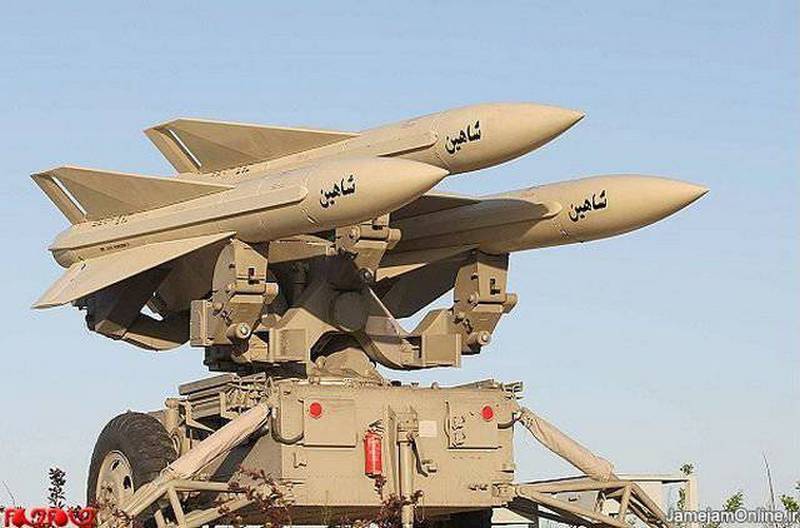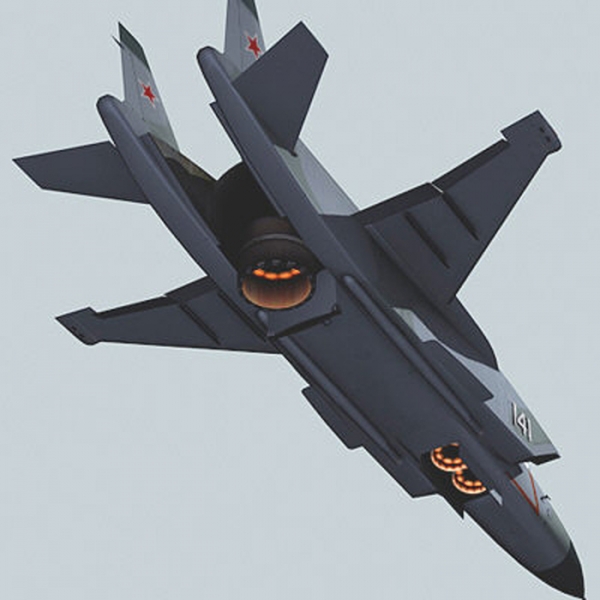
Yak-141 - multipurpose supersonic all-weather carrier-based aircraft vertical / short takeoff and landing (ST / APC) Yakovlev development. It has become the world's third VTOL (after EWR VJ 101 и Dassault Mirage IIIV), break the speed of sound.
Yak-141 – video
Intended to provide cover for aircraft carrier connections from enemy aircraft, winning and retaining air superiority, reference for maneuvering near and ranged, and to attack ground and sea targets. The aircraft was designed with the mid-1970s and made its first flight in 1987 year. anticipated, Yak-141 that will be part of Air Group heavy aircraft-carrying cruiser "Novorossiysk", "Baku" (future "Admiral Gorshkov"), "Tbilisi" (future "Admiral Kuznetsov"), "Riga" (future "Varyag") and "Ulyanovsk", replacements for worn their Yak-38 on the cruiser "Kiev" and "Minsk", and also to be used in the Air Force. However, tests of the new machine was delayed, and the first landing on the deck of aircraft carrier Yak-141 has made only 1991 year. The onset of the crisis after the collapse of the USSR, It happened to one of the prototypes of the accident, as well as prevailing at the time the negative attitude of the military to "vertikalka" in the amount of lead to the termination of funding and the closure of the project. Today you can see this plane only in museums.
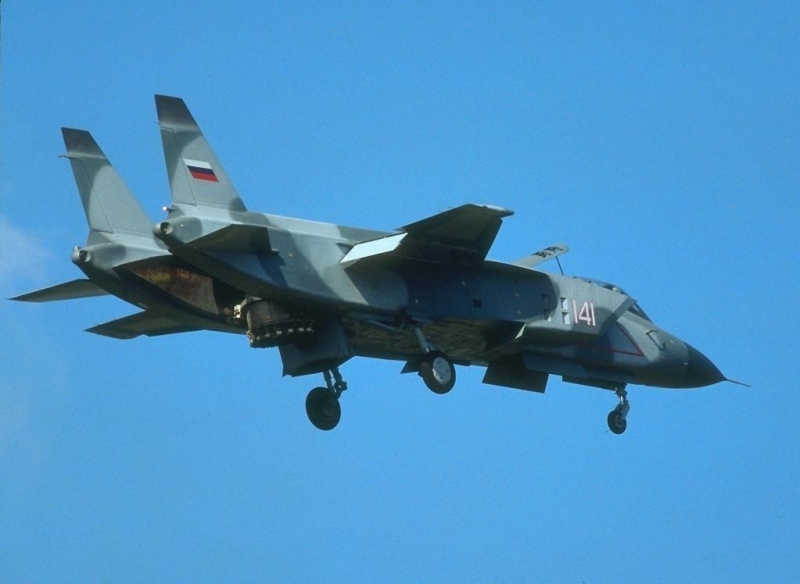
Yak-141 – vertical take-off
BACKGROUND OF THE
For a long time in the Soviet Union to deny the role of aircraft carriers, which was referred to as a "weapon of aggression". A similar weapon in the Soviet Union, According to the country's leadership, not needed. Navy saw the country's leadership as the only defensive, acting near native shores. As such, its air cover could well provide naval aviation airfield basing. A few projects of creation of aircraft carriers were closed at early stages, I did not bring to life.
However, the emergence in the late 1950s a new threat in the form of nuclear submarines with ballistic missiles forced the Soviet Union to enter the world's oceans. The main objectives of the fleet began to search for submarines, missile potential enemy and tracking them, that allows you to instantly destroy them if necessary. For this purpose, the first Soviet ship-based helicopters have been created - the Ka-10, Ka-15 and Ka-25. Last is widespread and has been added to the arming of large warships.
The next step was the design and construction of antisubmarine cruisers (PKR) project 1123 "Kondor". Aft of these ships had a broad Flight Deck, allows takeoff and landing operations simultaneously several helicopters. Air Group included 14 Ka-25 helicopters. However, during the operation of the two series of ships built, it was found, that in order to ensure continuous search and tracking submarines need to have on board more helicopters. Corresponding changes were laid in a scheduled construction to the third RCC.
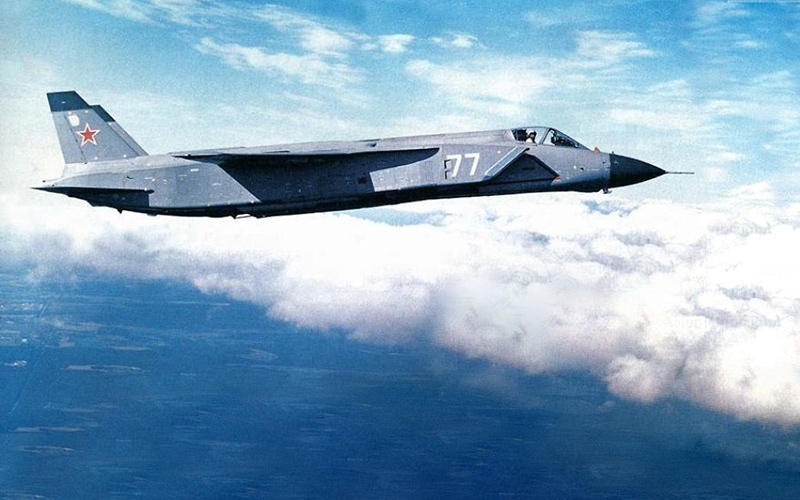
At the same time in the Soviet Union gained momentum program to create a vertical takeoff and landing aircraft (SVVP). Flying test bench - Turbolota, and then the experimental Yak-36 promoted intensively. After the demonstration, the Yak-36 senior political and military leadership of the country by plane interested representatives of the Navy. Designers tasked to study the possibility of using a VTOL was planning on a third RCC Project tab 1123 - "Kiev".
Yak-36, despite all the efforts of developers to improve its design, there was only an experimental machine, unable to bear at least some weapons. Nevertheless, his tests gave a significant amount of information, has helped to create a full-fledged combat VTOL Yak-36M, who had gone into the series as the Yak-38. Instead, the third "Condor" were designed and built a new class of ships - heavy aircraft-carrying cruiser (Thackray) project 1143 «Krechet». They were "firm" attributes carriers - shifted to the right add-in board ("Island"), Angle Flight deck and a large hangar with two underdeck samolotopodomnikami.
During operation of the Yak-38 have been identified serious shortcomings machines, reduces its combat potential. The plane had a small combat radius and a small combat load. Besides, Use "James" in the southern latitudes it has been greatly hampered due to deterioration of the traction performance engines at high temperatures. Improving the design of the Yak-38 was carried out in several stages. method of taking off a short run-up has been introduced for increasing the radius of combat (VKR). The next step was the development and launch of serial production of modernized version of attack aircraft - the Yak-38M. many projects have been developed to further improve the characteristics of Yak-38 (Once 38Y, Once 38MP, Once 38MTS and others.). The final step was to develop on the basis of "thirty-eight" new multipurpose aircraft Yak-39, which the, among other things, I had to carry an onboard multi-mode radar, that expands the range of weapons used. But all these projects have been gradually closed, while OKB Yakovlev forces concentrated on the development of an entirely new, already supersonic VTOL.
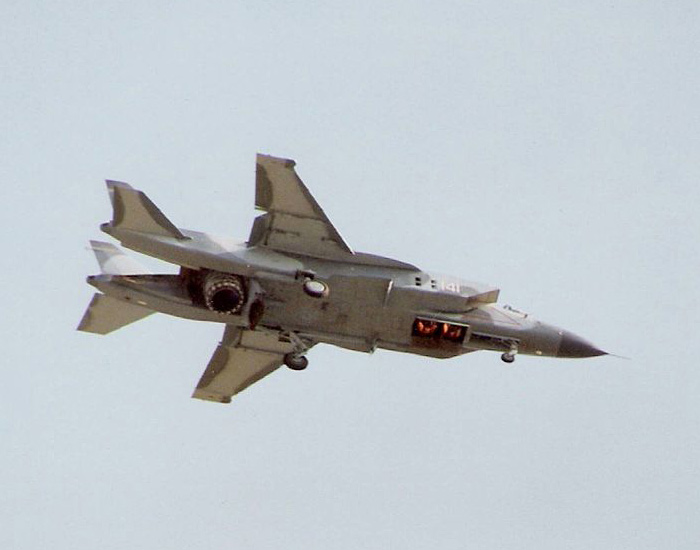
Yak-141 during a hover, seen deflected at -95 ° hoisting nozzle main engine, and two nozzle elevating motor
Design
The first study of the future shape of the aircraft began in November 1973 of the year, when the Yak-38 has not even made the first landing on aircraft carrier. anticipated, that supersonic aircraft will, It will have an onboard radar and increased combat radius. Despite, supersonic VTOL aircraft that have already been created abroad (German EWR VJ 101 and the French Dassault Mirage IIIV), they were all extremely proficient machine, while the new "Yak" was created just as a serial combat aircraft. So that, as well as the development of the Yak-38, designers had to go its own way. Creating new machine was linked to the creation of a fundamentally new lifting and sustainer engine - turbofans R79V-300 (product 79). Work on it went in AESTC "Union" under O. n. Tabor.
26 June 1974 year a directive of the Central Committee of the CPSU and the USSR Council of Ministers, which officially gave rise to the development of new VTOL and set the deadline for presentation of the finished project. At an early stage implied use of a single power unit with one rod PMD 15 000 kgf. first full-size aircraft mock-up was assembled. But in the course of the work on it was clear, that a car with such a layout would be almost impossible to stabilize the vertical flight mode. state commission, acquainted with the layout, I came to the same conclusions. Therefore, it was decided to move to a combined power plant, experience of creation and operation which had already received the Yak-38. AT 1975 year projected aircraft received the Yak-41 index and the internal designation of the product 48. Another directive of the Central Committee and the Council of Ministers, appeared 11 November 1977 of the year, He prescribed Yakovlev and AESTC "Union" to develop, respectively, GDP deck fighter Yak-41 R79V and PMD-300 for him. The Directive contains a list of basic requirements to them, as well as the deadline for submission of the aircraft on the state tests - 1982 year. 30 of March and 5 April 1978 , their requirements for the new machine presented, respectively, Commander of the Navy Admiral of the Fleet of the Soviet Union Gorshkov and Air Force Commander Air Chief Marshal Kutakhov.
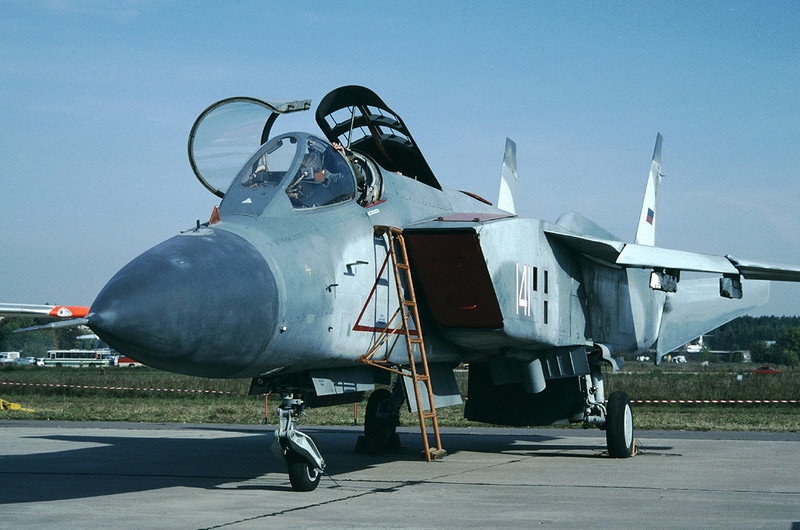
The first time an option for layout, wherein two lifting motor (Eng.)Russian. They were placed in the nose of the aircraft, between the radar and the cockpit. However, it turned, in this case their exhaust gases will get into intakes lifting and propulsion engine. It was then decided to use the scheme of the Yak-38 and PD-place compartment behind the cab pilot. PMD had only rotary nozzle, which was to be located near the mass center plane. Therefore, designers have to use a custom circuit with two female engine exhaust zone cantilevered beams, which were placed on the vertical tail and stabilizers tselnopovorotnym. In contrast to the Yak-38, which was a mid, "Forty-one" designed as vysokoplan, and his wing was to have special nodules in the root of the. Like many decked aircraft, Yak-41 was folded wing, it fills up less space in a hangar aircraft carrier.
By July 1980 year general questions about the arrangement and internal structure of the Yak-41 were solved, and EDB launched a detailed study of the project. case, when P79 does not provide the desired characteristics, The variants use instead a heavily modified turbofan D-30. However, work on this line were discontinued in 1982 year on the personal orders of General Designer A. FROM. Yakovlev. new layout was assembled, who successfully passed the state commission (it was headed by Colonel-General A. n. Tomaševskij). This was followed by a decision on the construction of an experimental batch of four aircraft. The first machine (product 48-1) intended for ground testing of the power plant and all onboard systems. second (product 48-2) and third (product 48-3) machines were lotnymi samples, which were intended, respectively, The test in the normal flight mode, and a mode of GDP. The fourth machine (product 48SI) designed for static tests. At the same time we were working on a training version of "Yak" with a lengthened fuselage and tandem pilots seat, received index Yak-41UT and internal designation product 48U. It is also supposed to study the possibility of creating a stormtrooper on the basis of the machine.
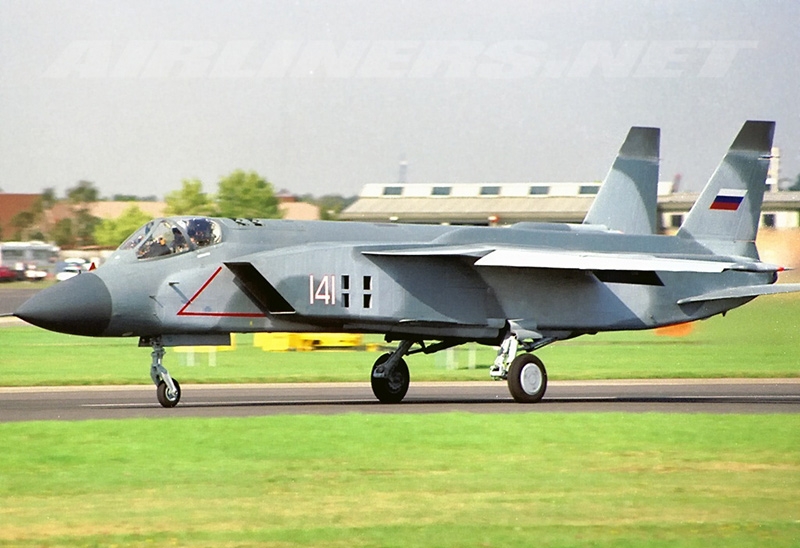
The bureau had planned to begin flight tests in 1982 year, as it was prescribed by the Directive Council of Ministers. But encountered technical difficulties were not allowed to meet the deadline. One of the main problems was the development of the rotary nozzle for PMD. Initially AESTC "Soyuz" The variants of a flat two-coordinate nozzle, but due to lack of experience in this field, it was decided to go to the traditional axisymmetric nozzle. original solution has been used for its turn - the nozzle was divided into three segments, that, rotating in opposite directions relative to each other, provide thrust vector deflection in a vertical plane to an angle of 95 ° (He was used to the GDP). To implement a short takeoff running start position in the nozzle became 62 °. For the first time in world practice, it was possible to use the afterburner as horizontal, and the vertical modes (although according to some sources nozzle similar designs had already been developed and tested by Rolls-Royce on the ground stand). Due to delays in the development of the nozzle 25 November 1983 , the order came, I save the Yak-41 on state tests 1985 year.
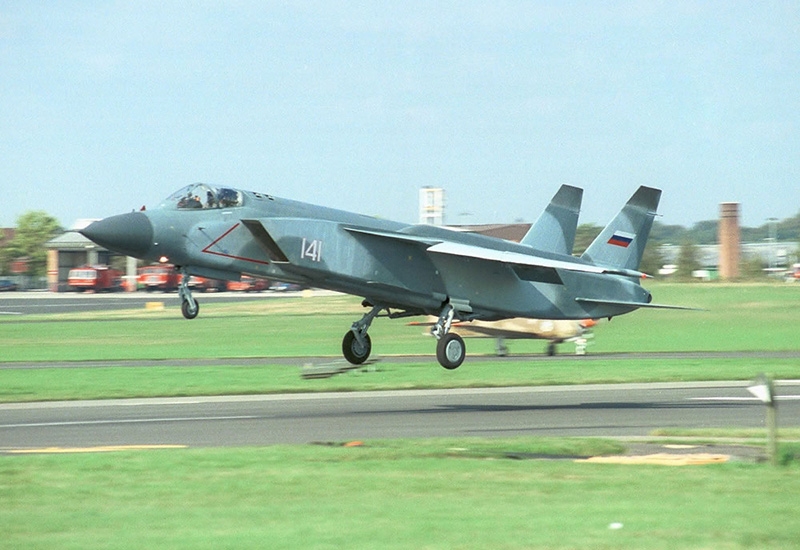
Take off the Yak-141 on the airplane after takeoff on the strip
Incomplete testing
In the first quarter 1984 , the assembly of the sample for ground testing has been completed (product 48-1), which received hull number 48. However, to carry him out of the assembly shop at the test site was only in June due to delays in delivery of the first engine R79V-300. The second engine is ready to flights brought in July - it is intended for testing flying laboratory Tu-16LL (b / n 02), which began in August,.
Second half 1984 the year was difficult for the project - 17 August retired general designer Alexander Yakovlev Design Bureau, a 20 He died December Defense Minister D. F. Ustinov, who was a strong supporter of the use of VTOL. However, work still continued. It was decided to build a stand of forces and moments (SSM) for product testing 48-1. Their aim was to determine the operating parameters of the power plant at various positions of the aircraft in space. The main thing was to determine the effects of engine exhaust of the aircraft skin. The tests included three stages: step "G" - working level flight mode, I continued with 26 September to 12 December 1984 of the year; Phase "B" - hover, 8 February - 25 August 1985 of the year; and the last stage - the machine testing on the transitional regime of the hovering to horizontal flight and back, which lasted from 5 June 1986 years before 24 April 1987 of the year. Total for this period was carried out 94 start the powerplant, and during the 1989 year - more 63. Later, at 1991 year, CCM was used to measure the exhaust gas impacts on underwing pylons suspended on objects, To make sure, that the weapons do not overheat and does not detonate during GDP.
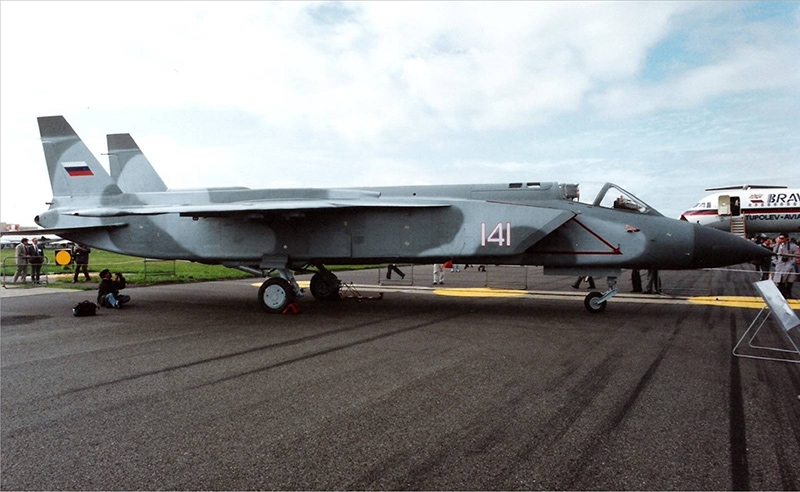
Second Yak-41 (product 48-2, first flight pattern) He was finally assembled in December 1985 , and received w / n 75. He had a major difference from the first prototype - he had jet rudders to deflect the course, Located at the end of tail beam. At the same time, experts from the bureau finally managed to get R79V-300 engine with the required maximum thrust in 15 500 kgf. He was immediately installed on the aircraft, which the 5 May 1986 year taken to the LII. Gromova. In July, the assembly of the product was completed 48SI, started testing 5 September. The tests continued until 31 March next year.
At this point, it proved to be another bad test progress factor - the customer has started to change its requirements for future aircraft to. He now had to become a multi-purpose, capable shortened takeoff, carry a large range of weapons and built a cannon GS-30-1, but also have more advanced sighting and navigation system. The plane gets a new index of the Yak-41M and 48M domestic product designation. Representatives of the Air Force and Navy had shown its full-size layout. Specialists of the Saratov Aviation Plant (here assumed mass production machines) counted, that the entire production cycle of a new "Yak" is 420 day. At the same time, an experimental batch of tests constantly delayed due to the failure of AESTC "Union" terms of delivery engines.
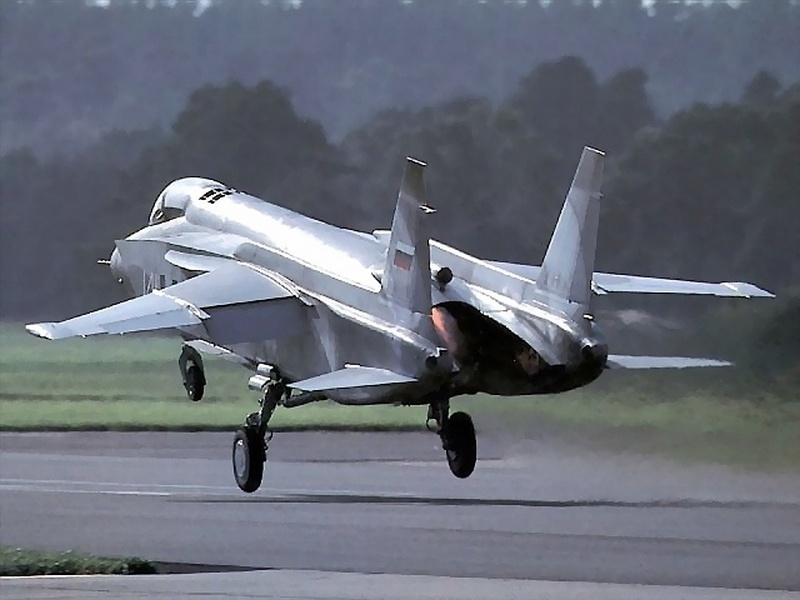
In February 1987 CIAM year issued a report, which gave good-flying Yak-41. Leading test pilot of this program was the A. A. Sinitsyn, who already had flight experience on the Yak-38. First, he trained on a simulator developed by OKB Yak-41, and then I spent a lot of time on the product 48-1 (it is still in the SSM), getting used to the behavior of the machine. This was followed by taxiing on the runway, and hovering at low altitudes have a sample of flight, products 48-2. 9 Martha 1987 , Andrei Sinitsyn first raised the "forty-one" in the air and made it to the first flight of the airplane's profile. 12 and 16 March were carried out two more similar flight. After this three-engine P79, with articles 48-1 and 48-2, and tested for the Tu-16LL, They were returned to the manufacturer for inspection and making some changes. During 1989 year was committed more 6 fly to horizontal mode.
At the same time, the new aircraft was detected by US intelligence satellites and received a temporary code word RAM-T («RAM» means the place of the detection of previously unknown LA - Ramenskoye airfield). spring 1988 year "Yak" was first publicly mentioned by Rear Admiral William Studemanom, Director of Naval Intelligence of the US Navy, already under the designation Freestyle. The image of the new Soviet VTOL aircraft appeared in the yearbook «Soviet Military Power». Besides, there is information, that the Yak-41 could carry codenamed Fulmar.
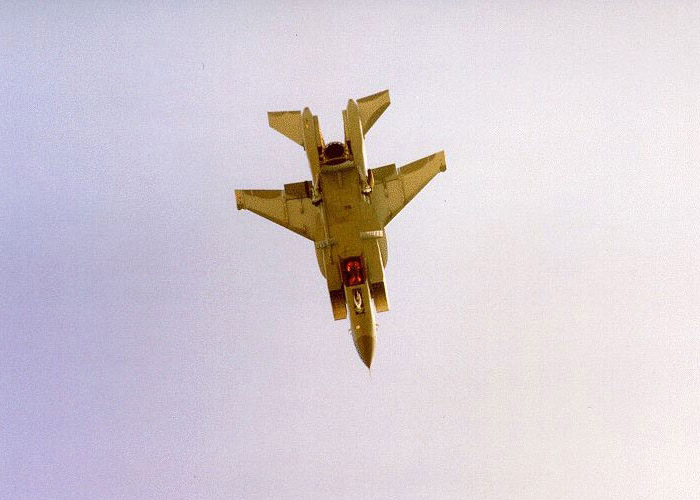
In June 1987 Year ended assembly of the second sample of flight (product 48-3), received w / n 77. Unlike the first sample, Here jet rudders at the ends of the tail beams missing - they were replaced by only a small rotating nozzle in the nose of the car. housing construction in many places has been strengthened after receiving the results of research, carried out on the product 48SI. 2 April 1989 the year he made his first flight. Due to the slippage of the machine designation was changed again - the Yak-141. 29 December the first flight in the hover, a 13 June 1990 year - already full profile, with vertical takeoff and landing. TO 30 January 1991 the number of flights on the two cars reached 108.
In April 1991 year test pilot Andrei Sinitsyn confirmed the unique capabilities of the machine, put on the "What" 12 world records for the climb, maximum load and flight height with load. Despite, that the flights were not conducted in ideal conditions (temperature was higher +15 °C), they showed the superiority of the machine on the "Harrier" in the presence of suspended loads (without Yak-141 inferior rivals in skoropodъёmnosty). In this case, the stock remained due to the increased temperature of about 10 seconds for a possible follow-up records.
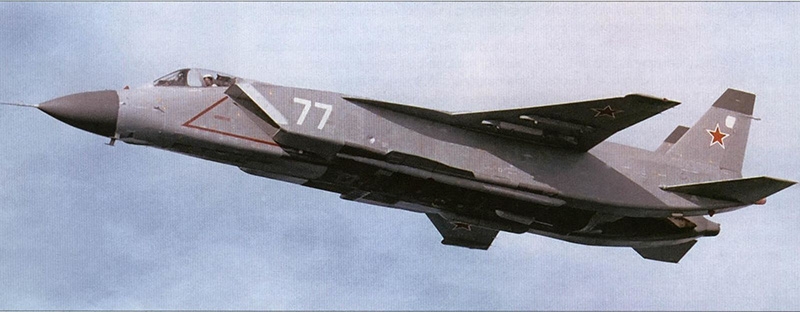
24 September 1991 flight, the two samples were sent for testing in Severomorsk on board the aircraft carrier "Admiral Gorshkov the Soviet Union". 26 September A pilot. A. Sinitsyn first landing on the deck of the aircraft carrier was made. Through Time. A. Yakimov led the second plane. 30 September was carried out the first take-off from an aircraft carrier. The purpose of the test was to determine the compatibility of the aircraft and its systems with the ship, as well as working out an emergency start - breadth of flight deck directly from technical positions. However, before working out the second paragraph, it never came because of the accident.
5 October 1991 year test flights began at noon. Sinitsyn first flew in the first instance lotnom. Then he was supposed to go on the second Yakimov. His plane was heavier - more fuel was poured into the tanks, and on underwing pylons were suspended models of missiles. Pilot also makes a rise short takeoff, I made a circle and started landing approach. The plane approached slowly and finally hovered above the deck. However, he began to decline rapidly, than you should. The car fell to the deck, main landing gear struck the walls of the tank with fuel, and started a fire. After repeated commands flight leader Vladimir Yakimov catapulted, and he was immediately picked up by the crew of the rescue boat. The pilot was not injured. Burning the same plane extinguished, but it turned out, that not restore it possible to fly. The cause of the accident was pilot error, who allowed limit excess rate of descent. At the same time, the head of flight gave the pilot instructions to ensure the safe rate of descent.
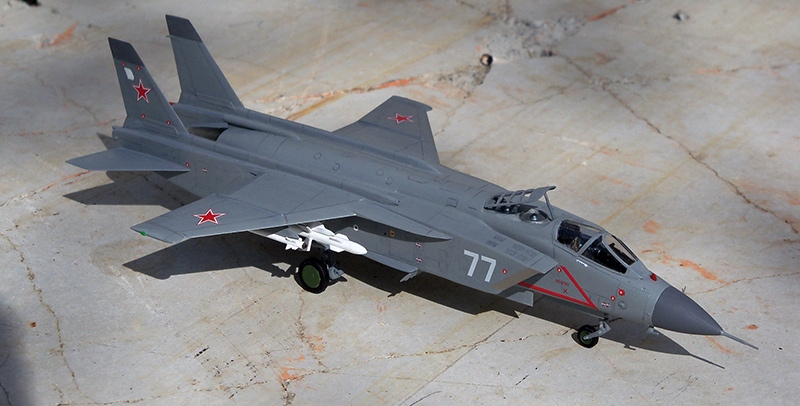
Closure of the work and the current state
Failure of the second "Yak" was a real blow for the entire program. It served as a formal pretext to suspend tests, although earlier it was planned as part of the Yak-141 and state tests of the new aircraft carrier "Admiral of the Fleet of the Soviet Union Kuznetsov". In the conditions of a disintegrating economy now-defunct Union to find funds for the construction of another prototype crashed in return and continued testing was impossible. Besides, the military at this time has formed a negative attitude toward "vertikalka" in general, caused disappointment after use stormtroopers Yak-38. The result of all this was to prevent the end of the 1991 year financing program, and then its final closure in 1992 year.
Then EDO staff tried to offer the Yak-141 foreigners. Remains intact copy of the first flight in the new color was first shown to the world public at the Farnborough Air Show in September 6-13 1992 of the year. The plane was high otsenon, but no order has not been received (potential buyers were considered India and China). Flight Yak-141 samples later were shown in Russia at the International Aviation and Space Salon (MAX) (products 48-2 and 48-3 - at 1993 year, and the product 48-2 - at 1995 year), but only in the static display.
To summer 1992 flight, the two samples in the amount of more than fulfilled 250 flights. During the tests it was found 12 world records of climb and flight altitude with the load. Serial production of promising aircraft and has not begun. In the 1980-1990 years in the Yakovlev Design Bureau on the basis of developments on the Yak-141 VTOL projects Yak-43 and the new-generation aircraft have been created, known as Yak-201, but they also have remained only on paper. Short EDO cooperation with the American company Lockheed Martin also came to nothing lead. Russian navy declined further work on the deck "vertikalka" and focused on aircraft with a horizontal takeoff and landing (Su-33, MiG-29K, Su-25UTG).
It is known the fate of only two of the four prototype Yak-141. To date, both the flight instance (products 48-2 and 48-3) are in museums - first at the Museum art Vadim Zadorozhnogo, the other in the Central Museum of the Russian Air Force. There is information, that the tail portion of the test specimen powerplant (product 48-1) It was used to recover the product 48-3 after the crash. What happened to the rest of his body - unknown. Also known location and state of the sample for static testing (product 48SI). Aircraft carrier "Admiral Gorshkov" is sold and rebuilt for the Indian Navy. Information on the development of new projects in Russia vertical takeoff and landing aircraft, as the mother ship for them, no.
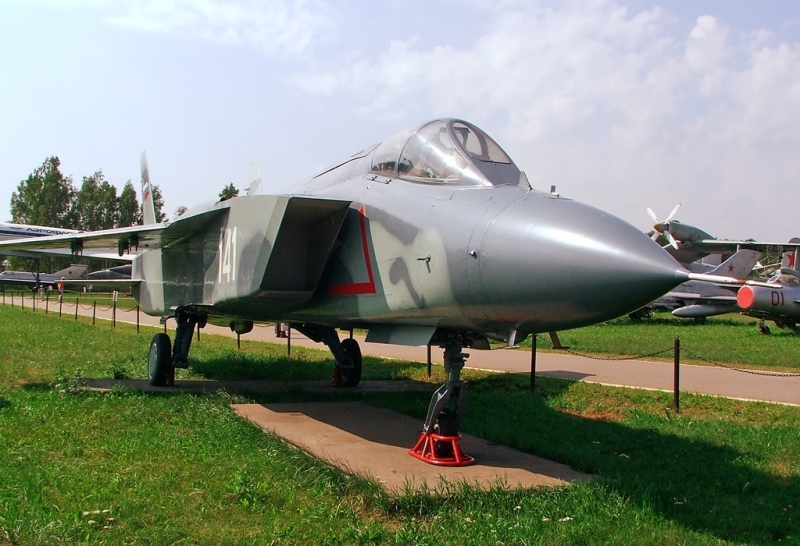
View of the bow of the "Yak" - clearly visible radar radome, cabin lёtchika, and the shape of the air intake
Design
planer
Yak-141 is a cantilever high, formed by normal aerodynamic scheme. Glider aircraft on 26 % (by weight) made of composites, the rest - from the aluminum-lithium alloys, having low weight and resistant to corrosion. Some structural elements are made of hardened steel and heat-resistant titanium alloys.
Fuselage
Semi-monocoque fuselage has a rectangular cross section and is formed by squares rule. In the lower part of four panel installed to improve the efficiency of vertical takeoff (2 mobile and cross 2 longitudinal fixed). In the tail portion, over soplom BDP, compartment located Parachute, intended to stop the aircraft during landing in case of a horizontal rotary nozzle failure.
Wing
Wing - trapezoid, sweepback, low elongation, It is at the root nodules. Parameters and wing profile selected so, to achieve supersonic speeds, opportunity to carry out a long cruising flight and drive agile dogfight. Sweep wing leading edge is 30 °. The angle of V cross-wing -4 °. To ensure based on the aircraft carrier wings are made folding, with its magnitude decreases with 10,1 to 5,9 m. The root and folding parts are situated rotary socks. Besides, in the root of the wing flaps are arranged, and on the emerging - aileron, having a mechanical connection with jet rudders.
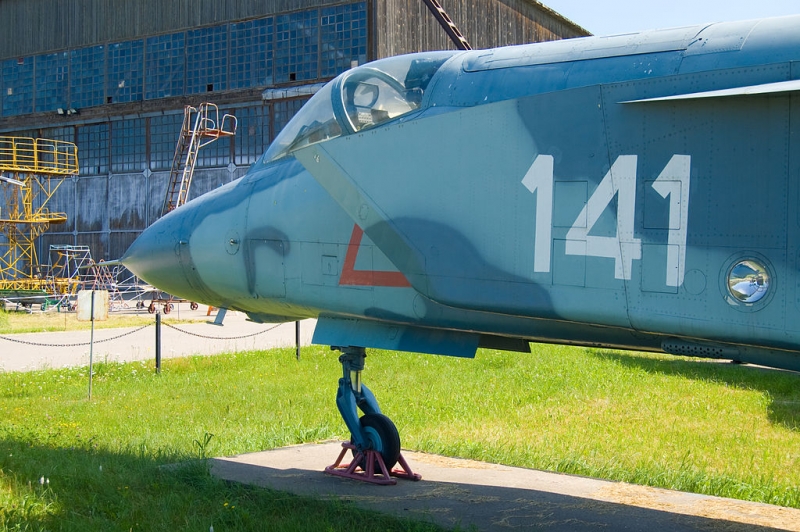
Air intakes are located on the side 4 a valve for feeding air PMD (painted over them b / n), slightly to the right is visible planting-rulozhnaya spotlight
tail
Empennage - dvuhkilevoe, fastening the two cantilevered beams for placing therebetween a nozzle lifting and propulsion engine. It involves rudders and stabilizers tselnopovorotnym. stabilizers Swipe is 5,9 m.
Air intakes
adjustable air intakes, rectangular shape. To adjust the flow section of the control system used by a deflected horizontal wedge. On the side surface of each of the air intakes are situated 4 valve for additional air feeding MIT during its work on the ground. The left air intake, just behind the valve, It is planting-rulozhnaya spotlight (on the article 48-2 it is located on the bottom surface of the nose of the aircraft).
Chassis
Chassis tricycle with racks lever type. At the bow rack set KH-wheel 31 with the tire model 1 (500× 150 mm), and on the rear rack - one wheel CT 69/4 III, model 31A bus (880× 230 mm). The chassis can withstand impact with the ground, an equivalent plane falls from height 5 m.

The power plant of the Yak-141. Showing: Red - engines. Blue - jet rudders and air sampling channels at MIT
Power point
Power plant Yak-141 consists of a hoisting main engine R79V-300 and two lifting RD-41. Also for inkjet maneuvering wheels are used for vertical flight,, powered by MIT.
Hoisting-boosters
Hoisting-boosters R79V-300 development AESTC "Union" is located inside the aircraft body. Air is supplied to it by two spaced air inlets. Engine Turbofan with afterburner and thrust vector control. engine features are: opposite the direction of rotation of the rotors, increased gas-dynamic resistance and the presence of unique compressor vortex burners in the main combustion chamber. The engine has a rotating nozzle with adjustable cross-sectional area of the critical, which allows the thrust vectoring in the vertical plane in the range of 95 ° regardless of the engine operating condition[40]. The engine delivers maximum thrust in 10 977 kg and at besforsazhny mode 15 500 kg when using afterburner.
lifting motors
Two lifting RD-41 development Rybinsk KB Motors arranged in a special compartment behind the cab pilot angle of 10 ° to the vertical axis. Parked or during horizontal flight this compartment is closed on top and bottom by protective flaps (1 from above, 2 from below), moreover top provides airflow to the PD. The valves automatically open when starting engines lifting. RD-41 - single-shaft, planimetric turbojet with a rotary jet nozzle tapering. At the end of the nozzle located rotary nozzles, which provides a thrust vector deflection in a longitudinal vertical plane through an angle of ± 12,5 ° from the longitudinal axis of the engine. The engine has a maximum thrust of 4100 kgf. PD can be operated at an altitude of no more than 2,5 km and airspeed, not exceeding 550 kmh.
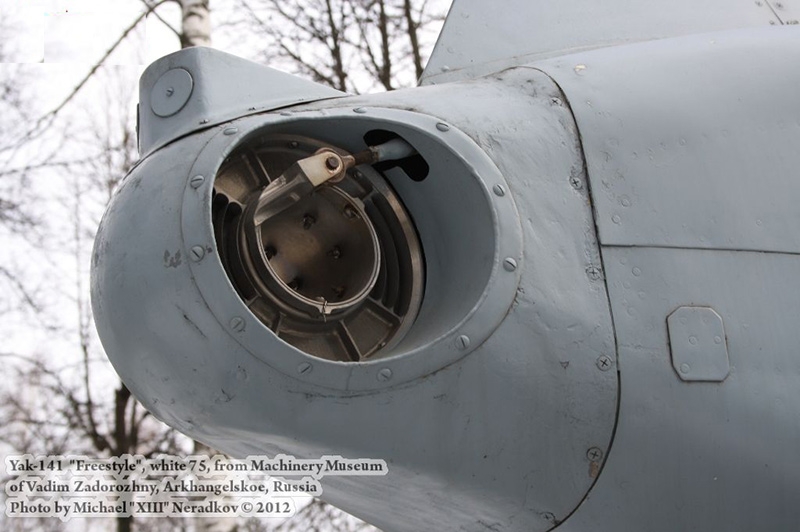
A machine with a b / n 75 in the tail ends of the beams are located Inkjet rudders
jet rudders
For maneuvering during vertical flight, when no effective conventional airfoils, an airplane fitted jet rudders, the air which comes from the MIT. For the rate control uses a single thruster, Placed in the nose of the aircraft (on the article 48-2 instead used two jet booster, placed at the ends of trailing beams). Two jet booster used for roll control, installed in the wingtips. Pitch control is performed by changing the ratio of rods PD and PMD.
fuel tanks
Fuel tanks are located in the fuselage of the aircraft (in its central portion and a tail portion of a cantilever beam), they are able to accommodate up to 4400 kg (more 5000 l) fuel. The design also provides for the possibility of placing a conformal fuel tank capacity 2000 l under the fuselage and several hanging on underwing pylons.
On-board equipment and systems
Avionics Yak-141 includes the following main components:
– Sighting and navigation system PrNK-48M (It combines elements of flight and navigation system (PNA) and various avionics and sighting equipment)
– communication and guidance complex
– recording equipment, control and signaling
– electrical power system
structurally, aircraft equipment located in three separate compartments: in the forward fuselage, in the area of air intake and MIT in the tail of a cantilever beam. Full list avionics Yak-141 and its block diagram shown in the collapsible box below.
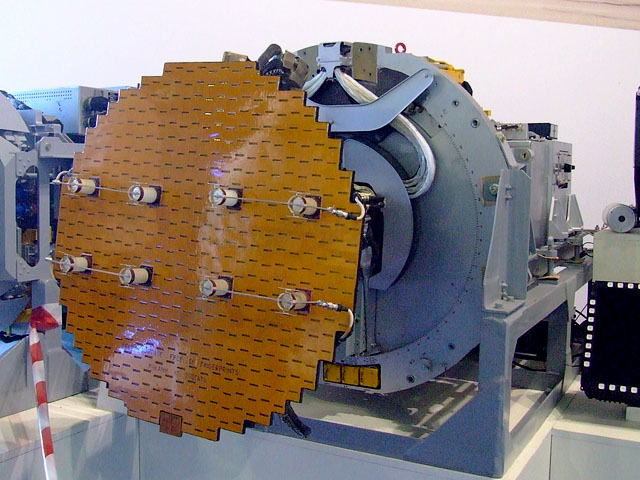
"Beetle" radar
Avionics and sighting equipment
The Yak-141 is used weapon control system C-41M (M - "modernized"), which is a development of the early projects SUV for the Yak-41 - C-41 and C-41D (D - "modified"). The system is built around a multi-mode airborne "Beetle" radar slot antenna grid (modification of the M002). This is analogous to radar radar MiG-29M, but it has smaller dimensions. Detection range of aerial targets with EPR 3 m² is 80 km, small surface vessels - 110 km. The station is able to accompany 10 goals, and also provides fire 4 targets simultaneously. Radar Massa - 250 kg. All incoming information is processed by an onboard digital computer and is provided with a pilot to help information display system. display means - head-up display, and multifunctional displays. Latest on experimental "Yak" is not used, although they were installed in a full-sized models Yak-41 Cab. The cabin of flight of the second sample, nahodyaschehosya in museums Vadim Zadorozhnogo, set the indicator line of sight (IPV). It was also planned to use a helmet-mounted target designation system.
Equipment IFF presented the "Password" system, antenna which is located on the nose of the aircraft, in front of the cockpit glazing. Elements electronic countermeasures systems are located in the wing tips and the tops of the fins. In the tail of the airplane can accommodate ejection automatic chaff and false heat goals. On the plane also has a weapon control system (SUO), which checks the status of aircraft weapons, placed on all points of suspension, preparation of the application and the subsequent start-up. On production Yak-141 involves the use of laser and television guidance system, conjugated with a laser rangefinder and on-board radar.
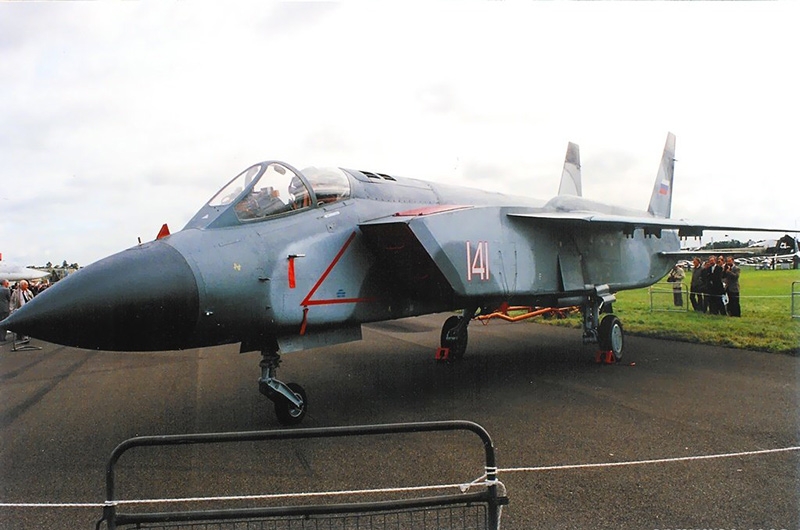
Flight control and navigation system
Navigation equipment Yak-141 consists of an inertial navigation system, radio range navigation RSBN-6C "Diamond" and the on-board equipment of automatic landing systems on the aircraft carrier "Resistor-K4". Besides, it is possible to use an airplane GLONASS satellite navigation system. Besides, flight control and navigation system includes system and aircraft trajectory remote control and some other components. To control both elements empennage, and jet rudders used completely standalone digital wire control system (EDSU) a three-time backup. There is also a spare mechanical control system (on one of the prototypes was installed analog EDSU and no spare mechanical SU).
communication and guidance complex
Represented by two meter radio range (MB) and decimeter (DMV) wave, voice alarm equipment and security equipment.
electrical power system
Yak-board power supply system 141 includes two three-phase alternating current generator (voltage 200/115 And frequency 400 Hz), two static converter, two rectifier devices and two accumulator /
recording equipment, control and signaling
It consists of a board embedded control and crew warning automated system, registration device and alarm system. Flight recorder is located in a compartment at the rear of the left tail plane beam (the first sample lotnom he is in a special compartment, PMD is located above the nozzle and shifted toward the left side).
Cabinet Yak-141
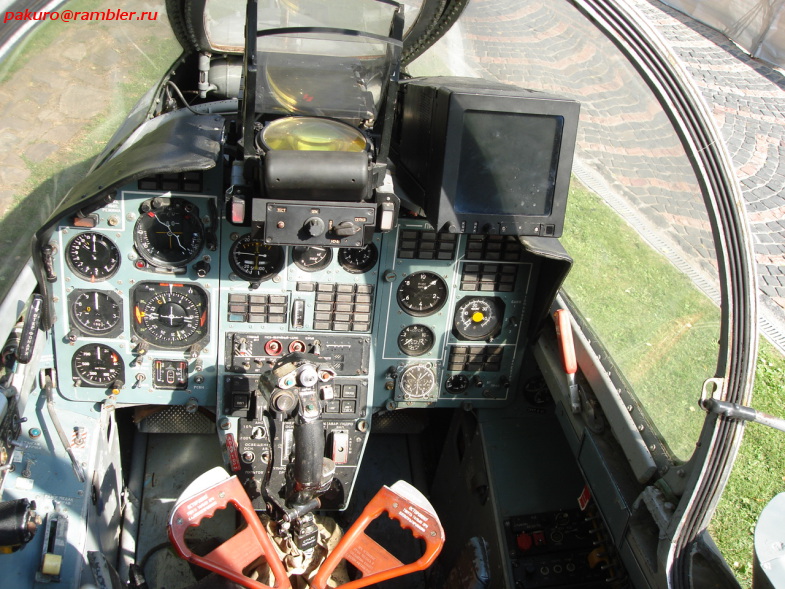
Cabin Yak-141 has a two-piece lamp Plexiglas with a flat Lobovyk with bullet proof glass. lantern discharged part opens to the right-side like the Yak-38. Pilot is located in an ejection seat K-36LV. On the vertical and transitional flight regimes automatic ejection system works (JUICE) second generation SC-EM. It is activated when a deviation from the horizontal PMD nozzle at an angle of more than 30 ° and is triggered when the aircraft certain combinations of angles and angular velocities of roll, dive and pitching. When the top flap closed PD, the bailout occurs after the shooting of lantern, if it is open - the pilot catapulted straight through the skylight glazing.
Instrument set of flight of the first sample comprises a set of analog indicator, some of which were later removed and replaced by a display on the windshield and the indicator line of sight. At the pre-production samples are also analog indicators, but the location of some of them more. As we noted above, on all the test machines multifunctional displays no, although they have been installed in one of the full-size mock-ups of the Yak-141 cockpit. On the serial "Yak" can be installed on the IFIs monochrome cathode ray tubes, similar MFI MiG-29M and MiG-29K.
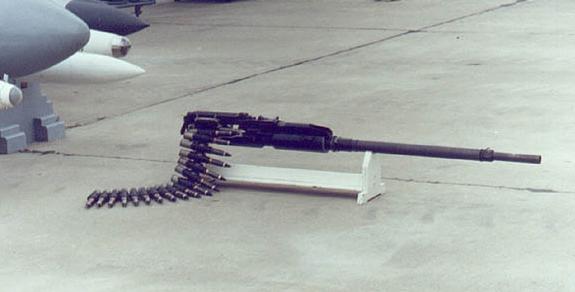
PR 30-1
As Vooruzhenye-141
"Yak" is armed with cannon GS-30-1. Additional arms can be mounted on 4 underwing pylons. Adopted at the Yak-141 nomenclature of weapons consistent with its purpose as a multi-purpose aircraft. Therefore includes arms missiles "air-to-air" short and medium range for combating air targets other; missiles "air-to-surface", anti-ship and anti-radar missiles to destroy ground targets, ships, Radar and communications of the enemy; as well as blocks NAR, gun pods and bombs svobodnopadayuschie, which allows the aircraft to perform the role of ground attack and bomber.
cannons
Aircraft cannon GS-30-1 Development Instrument Design Bureau is placed under the fuselage on the left side (it is fixedly secured and partially recessed into the hull of the aircraft). Single-gun, caliber 30 mm, used on most aircraft USSR / Russian production (MiG-29, Su-27 and others.). Boezapas - 120 shells. Gun is fitted with a water cooling system, and a mechanism to eliminate misfires. Weight gun - 50 kg, the rate of fire - 1500-1800 Venue / min. Firing can be carried out continuously or in bursts. Effective range at air targets - 200-800 m, on the ground / surface - 1200-1800 m. For firing can be used high-explosive-incendiary (OFZ) or armor-piercing tracer (BT) ammunition. The gun is effective against lightly armored ground, surface and air targets.
Also on the underwing pylons may suspend up to four UPK-23-250 gun containers. Each container comprises a GSH-aircraft gun 23L. rifle dvustvolynaya, caliber 23 mm. Boezapas - 250 shells. Curb weight of the container with ammunition - 218 kg (empty - 78 kg), the rate of fire - 3400 Venue / min. Effective range - 2000 m.
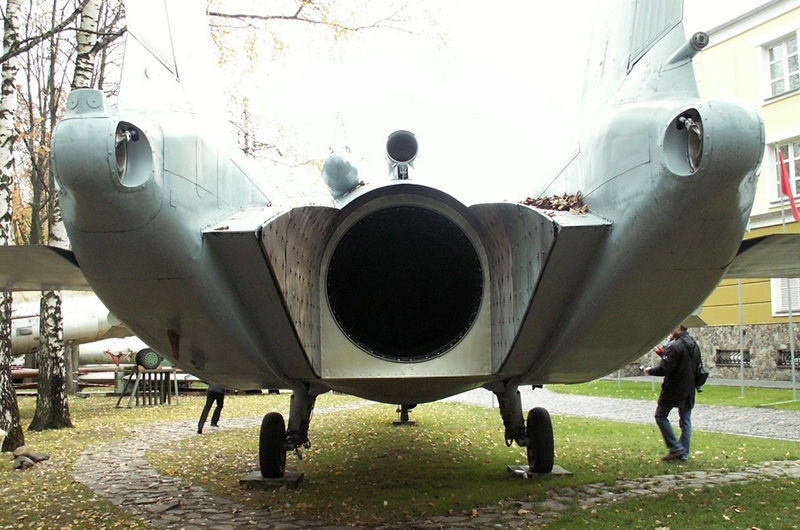
Guided missiles
Guided missile weapons is the ultimate in the Yak-141 arsenal. The aircraft is capable of carrying various modifications of R-77 (RVV-AE), R-27, R-73, R-60, X-25, X-31, X-35.
The rocket "air-to-air" low-range R-60 developed DESIGN production plant (PKPK, the future of NPO "Molniya"), and this is the first Soviet UR such class. Caliber rockets - 120 mm, weight - 43 kg, launch range - from 0,3 to 10 km (It depends on the height), airspeed - M = 2.5-3 . The missile is equipped with a thermal (infrared) homing. Options Warhead - high-explosive, Frag or rod. The Yak-141 can be applied as a standard, as well as an upgraded version of the missile - P-60M.
The rocket "air-to-air" short-range R-73 is also designed in NPO "Molniya". Caliber rockets - 170 mm, weight - 105-110 kg depending on the modification, launch range - from 0,3 to 40 km (also it depends on the modification), airspeed - up 2500 kmh. The missile is equipped with a thermal (infrared) homing hypersensitivity and Interference. Warhead rod type.
The rocket "air-to-air" medium-range R-27 developed at an engineering plant "pennant" (Future GosMKB "Vympel"). Caliber rockets - 230-260 mm depending on the version, weight - 253-355 kg, launch range - from 0,5 to 130 km (launch range and weight are also dependent on modification), airspeed - M = 4.5. missile modifications are equipped with a variety of homing. Warhead - high-explosive or rod. Perhaps the use of R-27R (with inertial semi-active radar homing) and R-27T (thermal (infrared) GSN).
The rocket "air-to-air" medium-range R-77 (RVV-AE) also developed the ICD "Vympel". Caliber rockets - 200 mm, weight - 175-225 kg depending on the modification, launch range also depends on the amounts of modification and 0,3 to 110 km, airspeed - M = 4-5. The missile is equipped with an active radar homing. Warhead - rod with mikrokumulyativnymi submunitions.
The rocket "air-surface" short-range X-25 developed EDO "Star". Caliber rockets - 275 mm, weight - 295-320 kg, launch range - from 2 to 40 km (launch range and weight depend on the modifications), airspeed - 400-900 m / s. missile modifications are equipped with a variety of homing. Warhead - high-explosive and high-explosive.
The rocket "air-surface" medium-range X-31 is also designed to EDO "Star". Caliber rockets - 360 mm, weight - 600-715 kg, launch range - from 7,5 to 250 km (launch range and weight depend on the modifications), airspeed - up 1000 m / s. There are two basic variants of the rocket - confusional (X-31P, passive radar seeker and warhead fragmentation Fragmentation) and antiship (X-31A, with an active radar seeker and penetrating warhead high-explosive shaped-charge). To "Yak" is possible to use both of these versions.
Antiship missile medium-range X-35 is also the development of OKB "Star". Caliber rockets - 420 mm, weight - 520 kg, launch range - from 5 to 130 km, airspeed - M = 0.9. The missile is equipped with an active radar homing. Warhead - high-explosive penetrating.
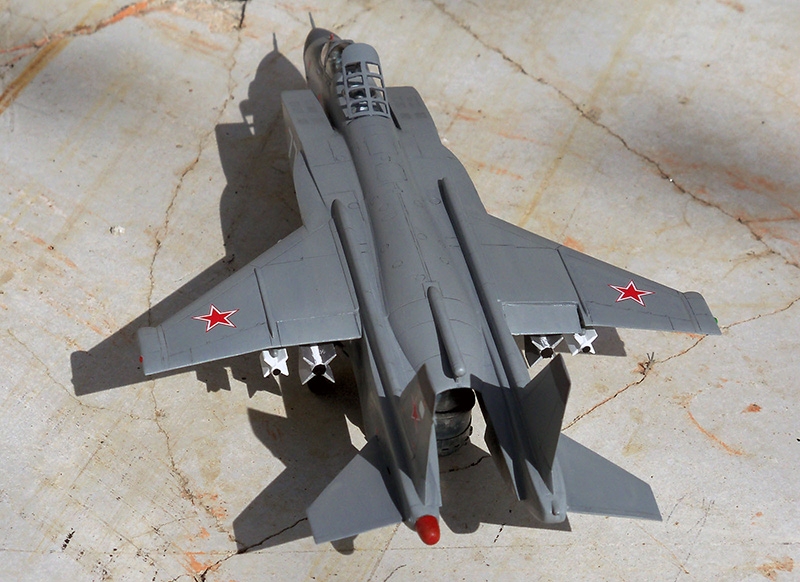
rockets
The armament of the Yak-141 included rockets and launchers blocks NAR caliber 80-240 mm.
– Blocks B-8M1 twenty missiles C-8 in each;
– Blocks B-13L with five missiles S-13 in each;
– AAP-68U launchers (UM and UM3) One rocket C-24 at each.
With air-launched rocket-8 developed in the design of precision engineering bureau (OKB-16). Caliber rockets - 80 mm, weight - of 11 to 15 kg depending on the modification, launch range also depends on the rocket modifications and ranges from 1200 to 4000 m. Block B is-8M1 20 launching tubes, weight of the empty unit - 160 kg. There are modifications of missiles with different types of warhead - cumulative-fragmentation (C-8KOM), concrete- (C-8BM), volume-detonating (C-8DM), Fragmentation (C-8DF, outfitted volume-detonating mixture), tandemnoy kumulyatyvnoy (C-8T), osvetitelynoy (On the 8th,), markirovochnoy (S-8CM), as well as with the CU as chaff (C-8nM).
Air-launched rocket C-13 developed by the Institute of Applied Physics (g. Novosibirsk). Caliber rockets - 122 mm, weight - of 57 to 75 kg depending on the modification, launch range also depends on the rocket modifications and ranges from 1100 to 4000 m. Block B-13L has 5 launching tubes, weight of the empty unit - 160 kg. There are following modifications missiles: with concrete-warhead (C-13), two-module with penetrating warhead (C-13T), high-explosive fragmentation warhead (S-13OF), volume-detonating warheads (C-13D), thermobaric warhead (C-13DF).
Air-launched rocket C-24 developed in the SRI-1 branch. Caliber rockets - 240 mm, weight - 235 kg, launch range - up 2000 m. Rockets placed one on universal devices launchers APU-68U (UM and UM3). Warhead - high-explosive, weight 123 kg.
bombs
Possible suspension to 6 aircraft ammunition freefall (ABSP) calibres 500 kg. This includes:
– Fugasnıe aviabombı - FAB-100, FAB-250, FAB-500
– High-explosive bombs - OFAB-100, OFAB-250, OFAB-500
– Betonoboynıe anti aviabombı - BetAB-500, PLAB-250
– Incendiary and volumetric-detonating bombs - ZAB-100, Tooth-250, BZ-500, FZAB-500, OFZAB-500
– Kassetnıe aviabombı - RBK-100, RBK-250, RBK-500
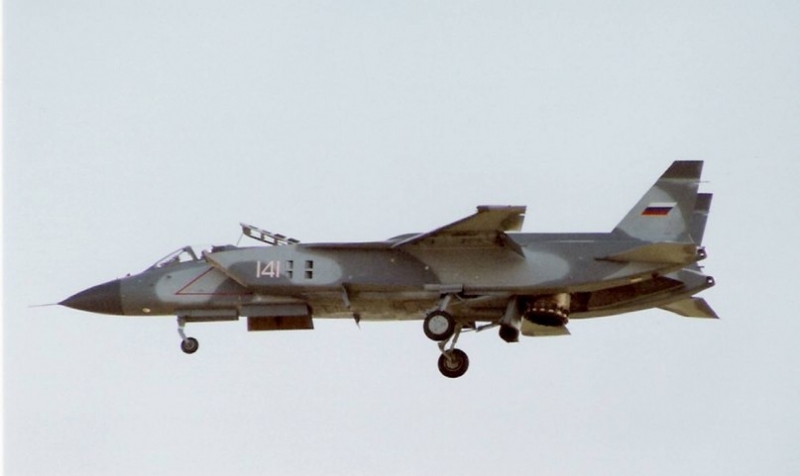
Yak-141 – vertical motion
Mothership
At various times, the Yak-141 was planned to include in the air group following vehicles:
Thackray project 1143 ("Kiev", "Minsk") - the first Soviet ships with air group of VTOL, joined the navy, respectively, at 1975 and 1978 years. anticipated, that the Yak-141 will replace served their Yak-38 of the ship's air group. However, due to delays in the creation of new VTOL designs and strong deterioration in both ships 1993 year were withdrawn from the fleet, I have not received new aircraft.
DEUT NA 1143.3 ("Novorossiysk") - the third Soviet aircraft carrier, It was built on the modified project, and its air group was to consist of already new supersonic "Jacob". Included in the composition of the fleet 1982 year. However, here again, the delay affected, and the ship took on board the Yak-38 subsonic. Withdrawn from the fleet in 1991 year, also not received new aircraft.
DEUT NA 1143.4 ("Soviet Union Fleet Admiral Gorshkov") - as "Novorossiysk", It was originally designed for VTOL Yak-141. Compared to the previous aircraft carrier had an increased deck area of the corner, and a special gaz baffling shield and the delay devices to provide a group with short takeoff aircraft takeoff. The hangar could accommodate 12 (according to other sources 14) Yak-141. As in the case of "Novorossiysk", Aircraft carrier "did not wait for" receipt of new aircraft and was armed stormtroopers upgraded Yak-38M. In September - October 1991 year "Admiral Gorshkov" passed the ship's stage of the Yak-141 test, but it happened 5 October crash of one of the machines has actually led to the closure of the program. Some DEUT 2004 It was sold and is being rebuilt for the needs of the Indian Navy, but as a carrier horizontal takeoff and landing aircraft (MiG-29K).
DEUT NA 1143.5 ("Soviet Union Fleet Admiral Kuznetsov") - the fifth ship of the project 1143 designed as a horizontal carrier aircraft takeoff and landing, but, Nevertheless, planned, that the Yak-141, along with the Su-27K and MiG-29K will be the basis of the ship's air group. Aircraft carrier could carry up 28 "One hundred and forty-first". On the deck of the ship they were equipped 3 Runway for vertical landing of aircraft (They were lined with heat resistant plates AK-9FM), and its launch could be carried out both with the third technical position (short run), and the first or second position - in this case used a springboard and increased combat load. However, delays in the development, and then the accident was not allowed to "Yak" to take part in the tests, held on board the "Admiral Kuznetsov" in 1989-1991. Currently, the aircraft carrier is part of the Northern Fleet of the Russian Navy.
DEUT NA 1143.6 ("Varangian") - a ship with the "Admiral Kuznetsov" type, but with some changes in design. I could carry the same amount of "Jacob". It has not been completed and is now owned by China.
ATAKR project 1143.7 ("Ulyanovsk") - the first in a series of aircraft carrier with a nuclear power plant. According to the original project was planned to have several Yak-141 as part of Air Group. He was cut on the slipway in 1992 year due to lack of funds for continued construction.
Besides, Northern PKB were worked out two projects under the VTOL aircraft carriers Yak-141 - "Mercury" and "Dolphin". They use a solid straight deck with 3-5 positions for vertical take-off and landing, and a springboard for takeoff with a short takeoff. Planned air group of not less than 10 "Jacob", as well as several helicopters Ka-27. The design of these ships was terminated after the closing of the Yak-141 program.
Also basing Yak-141 was assumed, in one embodiment, amphibious assault ship project 11780. Later on this option was abandoned. Development has been discontinued.
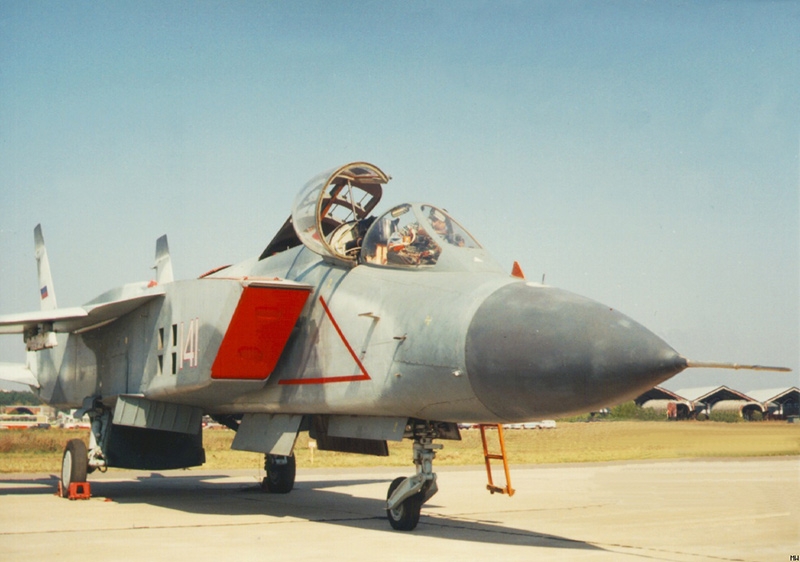
prototypes
A total of four test aircraft was built, two of them to stand, and two for flight test.
"Article 48-1" (plane with b / n 48) - the first of a series of prototype Yak-141, his build was completed in the first quarter 1984 of the year. It was intended for testing on the stand of forces and moments (SSM), which included the testing of the functioning of the power plant and check all machine systems. Despite the availability of engines, I could not fly. product testing 48-1 began in September 1984 year and continued until 1991 of the year. In the course of their work was scrutinized powerplant of the new "Yak", effect incandescent exhaust itself as a plane, and the hanging on underwing pylons arms. It is on the product 48-1 test pilot Sinitsyn first "live" acquainted with the power unit of the new fighter work. Except for product assembly 48-1 It resides in LII. Gromova. In the early 1990s, its tail part was used for restoring the crashed second instance of flight.
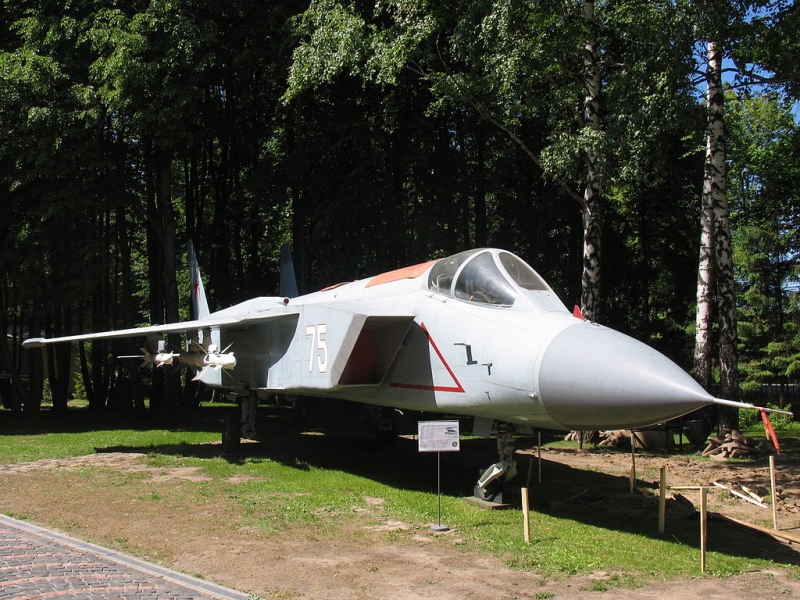
The first flying prototype (product 48-2) in museums technics Vadim Zadorozhnogo
"Article 48-2" (plane with b / n 75) - the first flying prototype, the second of a series of prototype Yak-141, its assembly was completed in December 1985 of the year, a 5 May 1986 , the aircraft was delivered to the LII. Gromova. The first flight of the product 48-2 committed 9 Martha 1987 of the year (pilot Andrei Sinitsyn). It was first presented at the Farnborough Air Show in September 6-13 1992 year with a new b / n 141, where made demonstrative flights (lёtchik Vladimir Yakimov). Thereafter he demonstrated on air show MAX-93 and 95, but only on static display. Then the plane was displayed at the Museum of the Yakovlev Design Bureau. In July 2009 It was transferred to the Museum of Technology Vadim Zadorozhnogo, where it is currently. The aircraft has an old painting, he returned to the old b / n 75, while the underwing pylons suspended layouts of R-73 and R-27R.
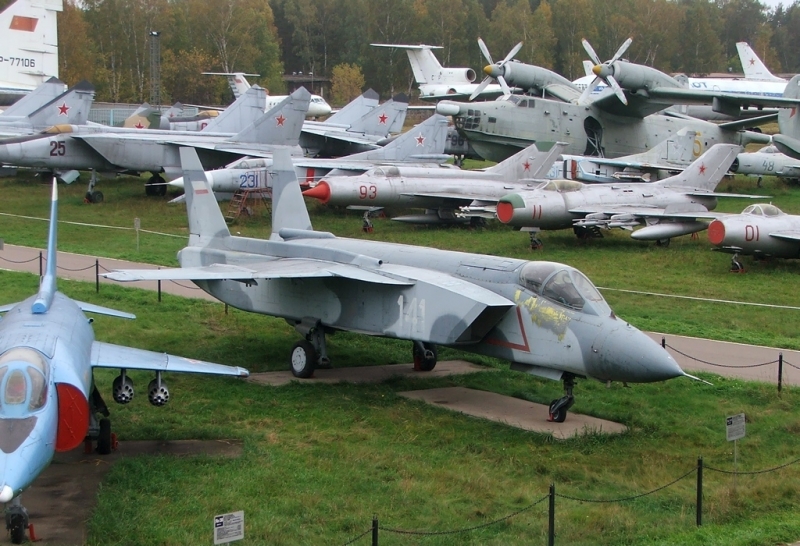
The second flying prototype (product 48-3) Central Museum of the Russian Air Force
"Article 48-3" (plane with b / n 77) - the third in a series of prototype Yak-141 and chronologically the last, pre-production copy of the flight. He was finally assembled in June 1987 of the year. I had differences from the first machine in the equipment and the complex layout of the cockpit, as well as some differences in design. It made its first flight 2 April 1989 of the year (pilot Andrei Sinitsyn). 5 October 1991 g. crashed (lёtchik Vladimir Yakimov was hurt) and it was later restored as a museum piece (at the same time he received w / n 141 and a new color). As such, the aircraft exposed to the static display MAKS-Moscow 93 at its site (Khodynka). Who it is in the Central Museum of the Air Forces at Monino. External testimony to the disaster is the lack of motor cars.
"Product 48SI" (plane without board room) - the last of a series of prototype Yak-141, chronologically the third, He was finally assembled in June 1986 of the year. Used for static tests (because the SI and letters in the title), which lasted from 5 September 1986 year on 31 Martha 1987 of the year. The test results were taken into account when assembling products 48-3 and development of the product 48-2. Place items 48SI is currently unknown.
Besides, at different times there were plans to build several more experimental machines:
"Article 48-4" and "48-5 The product" - to plan 1984 , they were to be equipped with similar products 48-3.
"48UT product" and "product 48UTSI" - respectively, flying prototype and model for static tests of a training version of the Yak-41.
According to more recent plans of planned construction at the Saratov aircraft plant an experimental batch of 8 Flight (1 sample for ground testing and 5 Flight Obraztsova Once 41M, and two flight models Once 41UT). These plans were never implemented. but, according to some sources, assembly of the first sample of flight doubles Yak-41UT not only started, but it was brought to the 85 % availability at the time of closure of the project.

The probable appearance double training VTOL Yak-41UT
As Modyfykatsyy-141
Yak-41 (product 48) - a project of the supersonic carrier-based fighter GDP, on which work began in 1973 year. On its basis, it was supposed to create a training aircraft Yak-41UT, as well as attack aircraft carrier-based GDP.
Once 41UT (48U product) - trainer version Yak-41 with lengthened fuselage and tandem pilots seat, I planned for mass production. Works were stopped due to lack of funding in the early 1990s.
Deck attack GDP based on the Yak-41 - I did not come out of the design stage.
Once 41m / Yak-141 (product 48M) - project as a multi-purpose VTOL ship, and land-based developments based on VTOL Yak-41. Due to the time-bound plane development backlog 1988 he received a new designation Yak-141. Was built 4 As a copy-141, including one pre-series. Serial production of the Yak-141 is not held due to the termination of funding 1992 year.
Yak-43 (product 201) - Stol (SUVP), "Land" version of Yak-41 with an enlarged area of the wing and engine NK-32 (maximum thrust 25 000 kgf, used at the strategic bomber Tu-160) with rotary nozzle. The project closed in the early 1990s due to lack of funding.
new generation aircraft project (known how Yak-201) - aircraft project 5th generation on the basis of Yak-141 VTOL, designed by the Yakovlev Design Bureau on its own initiative and at their own expense in the mid-1990s. Is made on a "duck" with a marked decrease in technology. The power plant was supposed to include a new MIT with a maximum thrust in 17 500 kg and mechanical drive lifting fan. The plane was supposed to have a mass in the opening and closing 21 500 kg (including 6000 kg fuel) and to combat load 4200 kg. Combat radius of the new VTOL had to make 2400 km at combat load 1 ton and 900 km at combat load 2 tons. Planned use of new weapons systems and avionics. He took part in the competition on the program PRL (the creation of a light tactical fighter for the Russian Air Force), but it was not accepted by the customer.
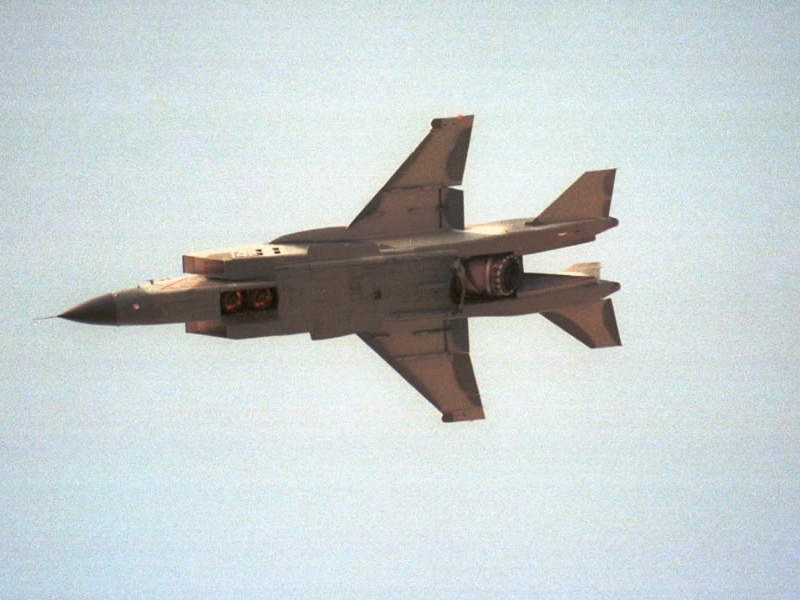
Yak-141 – transition to horizontal flight after vertical take-off
Flying
Takeoff
The Yak-141 is capable of taking off in six different ways:
– the usual way - the nozzle PMD retains the position on the 0 °, and lifting off engines.
– Short takeoff - at the same time lifting the engine is started after the onset of movement, and PMD nozzle starts to change the direction of thrust angle of 62 °. runway length in this case is about 120 m.
– Short takeoff and using delay devices - used when basing on aircraft carriers. To the plane did not move under the action of thrust, on the deck of aircraft carrier set special zaderzhivateli chassis wheels. Run at the same time reduced by almost two times and is about 60-80 meters.
– with an ultrashort takeoff - here are used zaderzhivateli, but before the start of roll nozzle PMD rotated through an angle of 62 °, and lifting the engine is started. Takeoff is reduced to 6 m.
– using springboard - suggests to "Jacob" based on the aircraft carrier project 1143.5, 1143.6 and 1143.7.
– upright - while incorporating lifting motors, PMD nozzle and rejected at a maximum angle of 95 °, It allows the engine to take off at any speed.
Landing
Landing Yak-141 can be carried out in two ways:
– the usual way - for this purpose on the plane has a parachute brake.
– upright - supposed to be used for basing on aircraft carrier.
The most important flights
Altogether during the test flight two Yak-141 samples was carried out more 250 flights. Below is a list of the most important ones.
record flights
Test pilot Andrei Sinitsyn during April 1991 Goda put on the Yak-141 12 world records, registered in the FAI.
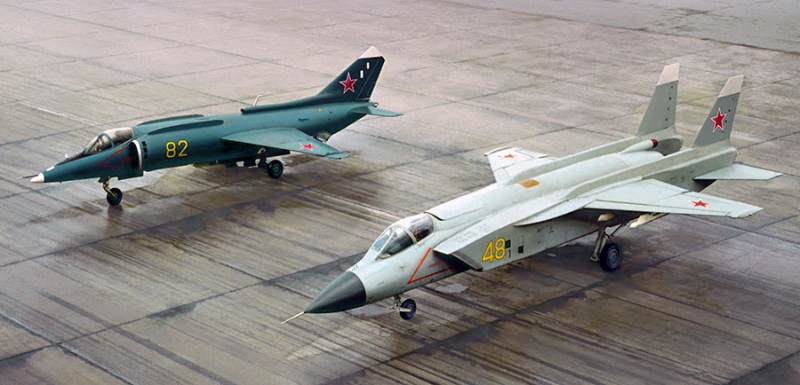
Yak-38 and Yak-141
Comparison with Yak-141 Yak-38 / Once 38m
The Yak-141 is a development of ideas, laid down in the Yak-38. but, Despite the similar layout (1 PMD and 2 AP), These machines have a number of differences. According to test pilot Andrei Sinitsyn, three important differences from the Yak-141 is the predecessor:
– good mechanization of the wing, making the aircraft more maneuverable;
– good thrust-to-weight ratio, making it possible to perform rapid acceleration after a vertical take-off, which is also fully automated;
– less braking distance (kilometers around, that approximately 2,5 times less than, than the "thirty-eight"), which enable the nozzle to reject PMD at -95 ° (wherein 5 create negative degrees horizontal component).
Besides, Yak-141, unlike his predecessor had onboard radar (The Yak-38 was able to attack only the target in sight pilot), and could "work" on the supersonic targets. Powerful propulsion system allowed to carry a wide range of weapons, and increased internal fuel tanks (at 1,6 fold compared to the Yak-38) together with PTB allowed to bring combat radius 900 km, it was almost 10 times more, than the "thirty-eight".
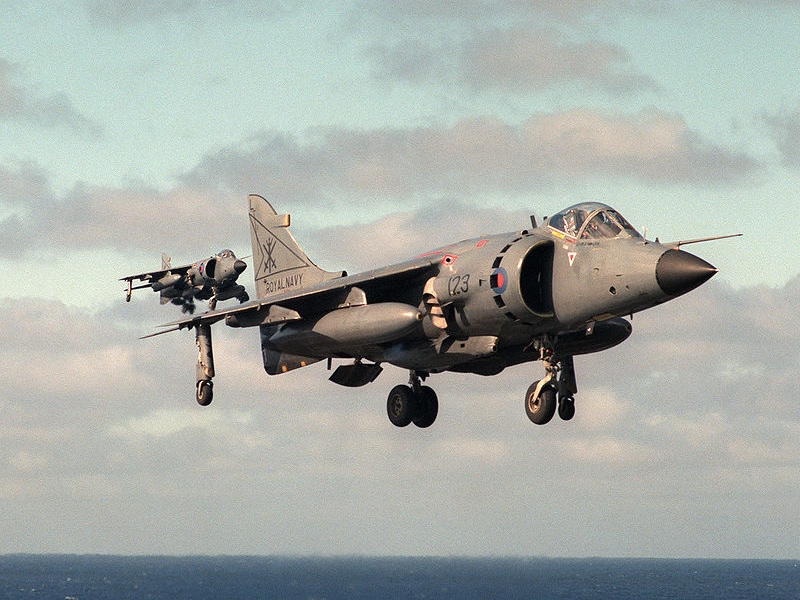
Airplane "You Harrier"
Compare Yak-141 VTOL type "Harrier"
Planes GDP of the "Harrier" were the first of this class of mass-produced cars are the main rivals of the Yak-38 and Yak-141. They were built for a different layout scheme - a single PMD, jet stream is sent by means of four small rotary nozzles. At the time of the first flight of the Yak-141 in the armed forces of NATO countries are already actively exploited by the second generation of the "Harrier" aircraft (BAE Harrier II и McDonnell Douglas AV-8B Harrier II), as well as the upgraded first generation machines. Still remaining subsonic aircraft, updated "Harrier" already had onboard radar.
According to Andrei Sinitsyn, maneuverability "Harrier" is better, something in the Yakovlev Yak-141, through the use of thrust vectoring. But in this case, a decrease of the horizontal component of aircraft braking and, that the real battle may cause. At the same time, the Yak-141 Andrey successfully "Cool Runnings", using afterburners, which "Harrier" deprived.
And "How", and "Harrier" used for setting records in the class VTOL. Without payload at altitudes up 3 km "Harrier" proved to be a better, but the rest of the Yak-141 is completely surpassed his rival.
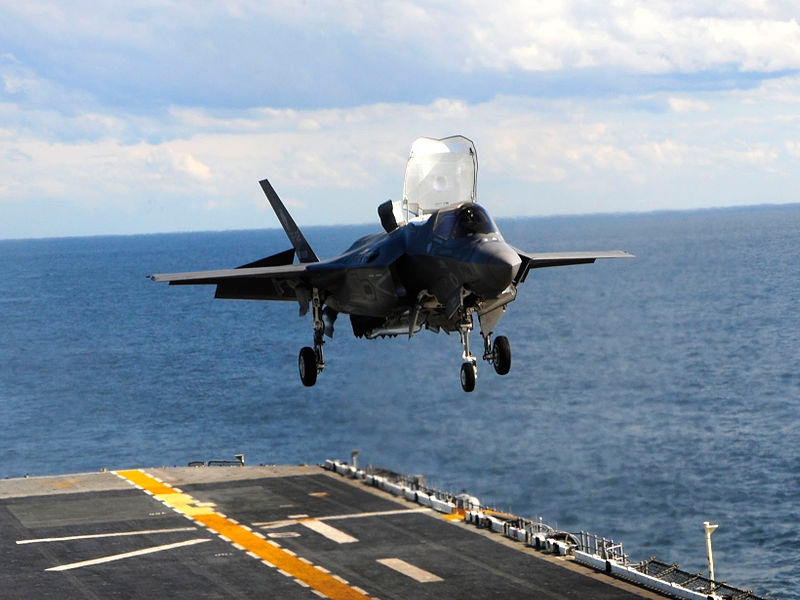
F-35B makes a vertical landing on the deck of "Wasp" landing ship
Compare Yak-141 to F-35B
F-35B (modification of F-35 GDP) very close to the Yak-141 design and layout. It also applied the combined power plant (1 PMD + 1 lift fan), with a lifting fan compartment (it performs the same function, and that the PD to "Yak") also placed behind the cockpit, a nozzle lifting and propulsion engine also embraced by the tail boom, although they are less than the length. nozzle design PMD and does use the idea, for the first time embodied in R79V-300 (rotating in opposite directions the segments). It happened, because in the mid-1990s, the company-developer of the F-35, Lockheed Martin, briefly collaborated with the Yakovlev Design Bureau. According to some reports, at 1995 yakovlevtsy year with Russian government permission was sold to the Americans all the documentation on the Yak-38 and Yak-141.
Another project of the supersonic VTOL aircraft of the fifth generation is the X-32B company "Boeing". It uses layout, as aircraft type, "Harrier" - with a single lifting and sustainer engine F119-614C. This engine is an engine modification, designed for aircraft the F-22 "Raptor", but in addition it has a flat nozzle front two small nozzles and jet rudders for GDP. The main advantages of X-32B, as the F-35B, to "Yak" - that is their stealth, the presence of internal weapons bay. Also, both aircraft are superior to Yak-141 to a maximum combat load - 2600 kg in the "What" against 6350 kg for X-32B and 6800 kg of the F-35B. Well, other than that, F-35B important advantage (as well as the latest versions of "Harrier") - is the ability to refuel in the air, that allows to increase the combat radius.
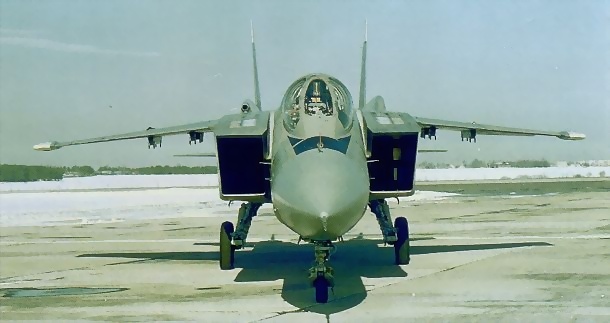
Tactical-technical characteristics Yak-141
– chief designer: AA. Levinskih (1973—1982), VN. Pavlov(1982—1988), KF. Popovich (1988—1992)
– First flight: 9 Martha 1987 of the year
– Status: closed project 2003 year
– units produced: 4
Yakovlev Yak-141 crew
– 1 human
The dimensions of the Yak-141
– Length: 18,3 m
– Wingspan in the retracted position: 5,9 m
– Wingspan in the unfolded position,: 10,1 m
– Height: 5 m
– wing area: 31,7 m²
As Wes-141
– empty weight: 11 650 kg
– Maximum takeoff weight during the run 120 m: 19 500 kg
– Maximum takeoff weight for vertical take-off: 15 800 kg
– Fuel mass inside: 4400 kg
– fuel mass in the FTB: 1750 kg
Engine Yak-141
Hoisting boosters R79V-300
– engine's type: Turbofan with afterburner and thrust vector control
– quantity: 1
– maximum thrust: 1 × 10 977 kgf
– thrust in afterburner: 1 × 15 500 kgf
– engine weight: 1850 kg
– thrust vector control: -95°
Lifting RD-41
– engine's type: planimetric turbojet with thrust vector control
– quantity: 2
– maximum thrust: 2 × 4100 kgf
– thrust vector control: ±12,5°
As Tyahovooruzhёnnost-141
– at maximum takeoff weight: 0,78/0,98 kg / kg
Speed Yak-141
– Maximum speed at height 11 km: 1800 kmh (M = 1,7)
– Maximum speed at ground: 1 250 kmh (1,05 M)
Range Yak-141 flight
– GDP at no load at an altitude of 10-12 km: 1400 km
– GDP at no load at ground level: 650 km
– when the load OHR 1 t. at an altitude of 10-12 km: 2100 km
– when the load OHR 1 t. near the ground: 1010 km
– combat radius: to 900 km
– loitering time away 100 km: 90 min
– The length of the run: 120 m (or vertical take-off)
Maximum overload: 7 g
Practical ceiling Yak-141
– 15 000 m
weaponry
– cannon: 30-mm aircraft cannon GS-30-1, 120 rounds
– Combat load during the run-up 120 m: 2600 kg
– Combat load during vertical takeoff: 1000 kg
– point of suspension: 5
– "Air-air" guided missiles: P-77, R-27, R-73, R-60
– "Air-surface" guided missiles: X-25, X-31, X-35
– Starting from the gauge blocks NAR 80 to 240 mm
– Up to six bombs caliber up 500 kg
Photo Yak-141
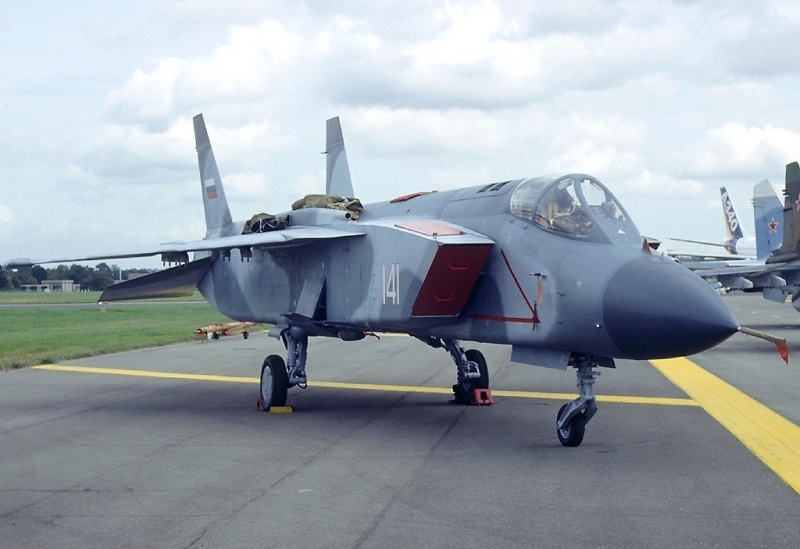
Yak-141 at the air show Farnborough 1992







